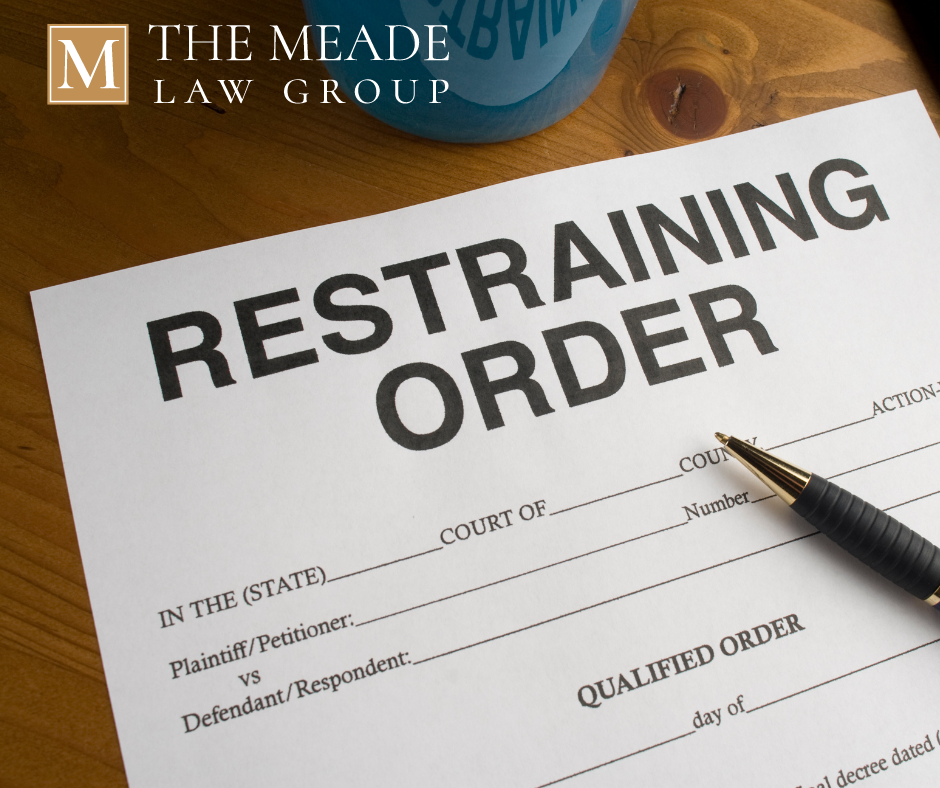If you or someone you know is experiencing a situation that feels unsafe, a protection order could be a lifeline. In Columbus, Ohio, these court orders are designed to protect individuals from harm, threats, and harassment. One of the most critical legal tools, they play a crucial role in cases of domestic violence, stalking, or menacing, providing a legal barrier between victims and their abusers.
While protection orders are essential tools for safety, they have real legal consequences for both parties involved. Understanding what they are, how to obtain one, and what they can and cannot do is vital for anyone navigating this complex legal landscape. Whether you are seeking protection or facing allegations, rest assured that you need support. Our goal at The Meade Law Group is to provide you with the information you need to make informed decisions.
This guide will break down the different types of protection orders available in Ohio, who is eligible to file, the steps involved in the process, and the potential consequences of violating an order. We want you to feel supported and informed every step of the way. Your safety is our priority.
What is a Protective Order?
In Ohio, a protection order is a court-issued legal document that prohibits one person (the respondent) from contacting or harming another (the petitioner). Think of it as a shield, creating a safety zone for victims of violence, threats, stalking, or other forms of abuse.
A protection order directs the restrained person to do or refrain from certain actions. Common provisions in a protection order include:
- No contact with the protected person in any form, including phone calls, text messages, emails, or social media.
- Staying a certain distance away from the petitioner’s home, workplace, or school.
- Refraining from further acts of violence or threats.
- Surrendering firearms or other weapons.
In some cases, a protection order can also address issues like child custody and visitation, temporary support, or possession of the shared residence.
Importantly, violating a protection order is a crime in Ohio, often carrying misdemeanor or felony charges depending on the circumstances and the specific terms of the order.
Types of Protection Orders in Ohio
There are several types of protection orders in Ohio, each designed for different situations and levels of risk. These are outlined in Ohio Revised Code Chapter 2919.26 and include:
- Temporary Protection Order (TPO): A short-term order, typically granted ex parte (without the other party present) before a full hearing, providing immediate protection while the case is pending.
- Civil Protection Order (CPO): A longer-term order, usually lasting up to five years, issued after a full hearing where both sides have the opportunity to present their case.
- Criminal Protection Order (CRPO): This type of order is connected to existing criminal cases and is often requested by the prosecutor to protect victims of crime.
- Stalking or Sexually Oriented Offense Protection Order (SSOOPO): This specific order is designed for victims of stalking or sexually oriented offenses.
Understanding the different types of protection orders and the legal process involved is crucial. If you need assistance, call us today; we are experienced in protection orders and can guide you through this process.
Who Can File for a Protection Order?
In Ohio, eligibility for filing a protection order depends on the type of order sought and the relationship between the parties involved.
Domestic Violence Civil Protection Order (DV CPO)
You can file for a DV CPO if you are a victim of domestic violence and have a specific relationship with the abuser, including:
- Spouse or former spouse
- Living together or have lived together
- Parent of a child in common
- Related by blood or marriage
- In a dating relationship
Dating Violence Civil Protection Order (DV CPO)
This order is available if you are a victim of dating violence by someone you’ve been dating, but you do not live together and do not share a child with.
Stalking or Sexually Oriented Offense Protection Order
You can file for an SSOOPO if you are a victim of stalking or a sexually oriented offense, regardless of your relationship with the perpetrator.
Criminal Protection Order (CRPO)
These are typically requested by the prosecutor on behalf of a victim of a crime, regardless of the relationship. However, victims can also initiate the process by informing law enforcement or the prosecutor’s office about the need for protection.
Important Note: In general, a minor child cannot file for a protection order on their own. However, a parent, guardian, or adult household member can file on behalf of a child.
If you are unsure whether you qualify for a protection order, it’s crucial to consult with an attorney who can assess your situation and guide you through the process. The Meade Law Group is here to help you understand your options and navigate the legal system.
How to Obtain a Protection Order in Ohio
If you are seeking protection from harm, obtaining a protection order in Ohio involves a specific legal process. While it can vary slightly depending on the type of order and the specific court, here’s a general overview of the steps involved:
1. Filing a Petition
The first step is to file a petition for a protection order at your local Domestic Relations or Common Pleas Court.
- You can usually find the necessary forms at the courthouse or online through the Ohio Supreme Court website.
- The petition will ask for details about the abuse or threats you’ve experienced, as well as information about the person you’re seeking protection from.
2. Ex Parte Hearing (Temporary Protection Order)
In cases of immediate danger, you can request a Temporary Protection Order (TPO) at the time of filing.
- This is an emergency order granted without the other party present (known as an ex parte hearing), based solely on the information in your petition.
- If granted, the TPO will provide immediate protection until a full hearing can be scheduled.
3. Full Hearing (Civil Protection Order)
Once a TPO is issued (or if you are initially seeking a CPO), a full hearing is scheduled, usually within 10 days.
- At this hearing, both you and the other party have the opportunity to present evidence and witnesses to support your case.
- The judge will then decide whether to issue a longer-term Civil Protection Order (CPO), which typically lasts up to five years.
4. Service and Enforcement
- Service of the Order: Once a protection order is issued, it must be officially served on the respondent (the person you’re seeking protection from) by law enforcement or a process server. This officially notifies them of the order and its terms.
- Enforcement of the Order: If the respondent violates any of the terms, it’s crucial to contact law enforcement immediately. Violation of a protection order is a crime and can lead to serious consequences for the offender.
Important Considerations for Petitioners: Your Preparation Checklist
Aside from formal legal steps, your personal preparation and documentation are crucial for success. We know gathering evidence is difficult, but it is necessary for your safety and legal case.
- Legal Representation: Having legal counsel can be extremely beneficial. An attorney can help you navigate the process, gather evidence, and prepare for hearings.
- Evidence is Power: Gathering evidence to support your claims is important. This can include:
- Police reports and medical records.
- Photos of injuries or property damage.
- Text messages, emails, or social media communication (print and timestamp everything).
- Witness statements (names, contact info, and short summaries of what they saw).
- Safety Planning: While obtaining an order is important, it’s crucial to create a safety plan to protect yourself and your loved ones. Never rely only on the paperwork.
What to Do If You Are Served with a Protective Order
Being served with a protection order can be a stressful and confusing experience. We understand how unsettling this is, but it is crucial to remain calm. These orders are legally binding, and violating them can have serious consequences, including criminal charges.
Here’s what you need to do if you find yourself in this situation:
- Read the Order Carefully: The protection order will detail specific restrictions and requirements. You are legally obligated to abide by its terms.
- Contact a Criminal Defense Attorney Immediately: It’s essential to seek legal counsel as soon as possible. An attorney specializing in protection orders can explain your rights, assess the potential consequences, and advise you on the best course of action.
- Attend All Hearings: You have the right to a hearing to contest the protection order. Failing to appear could result in the order being granted by default.
- Obey the Order: Regardless of whether you agree with the order or plan to contest it, you must obey its terms while it is in effect. Any violation can lead to criminal charges.
- Gather Evidence: If you believe the protection order was filed unjustly, your attorney can help you gather evidence to challenge it.
Protecting Your Rights as a Respondent
- Don’t Panic: While receiving a protection order is a serious matter, remain calm and seek legal guidance.
- Don’t Retaliate: Avoid any contact with the petitioner or any actions that could be interpreted as violating the order.
- Don’t Go It Alone: Navigating the legal complexities of protection orders can be challenging. Having an experienced attorney by your side can make a significant difference in the outcome of your case.
The Meade Law Group is here to provide you with expert legal advice and representation if you’re facing a protection order. We understand the intricacies of Ohio law and can help you protect your rights and interests throughout this process.
The Meade Law Group Difference
Navigating the complexities of protection orders in Ohio can be a daunting task, whether you’re seeking protection or defending against allegations. These court orders have serious implications and require a thorough understanding of your rights and responsibilities under the law.
If you’re facing a situation that involves domestic violence, stalking, or any form of threat, remember that you are not alone. The Meade Law Group is committed to providing compassionate and effective legal representation to victims and respondents alike.
We understand that every situation is unique, and we are here to tailor our approach to your specific needs. Our experienced attorneys can guide you through the legal process, advocate for your interests, and help you achieve a resolution that prioritizes your safety and well-being.
If you have any questions or require legal assistance with a protection order in Ohio, don’t hesitate to contact us for a confidential consultation.
Your peace of mind is just a phone call away. Contact The Meade Law Group today.


